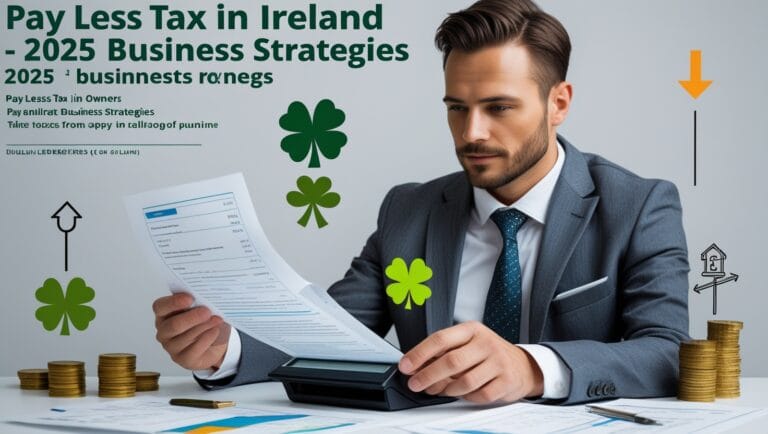How To Pay Less Or Avoid Tax By Business Owners In Ireland
Tax is often the greatest financial obstacle, hindering the retention of earnings and wealth accumulation. Wealth accumulation is fundamentally about keeping the money you earn rather than just earning more. As a business owner in Ireland, you have the right to legally reduce your tax burden. Paying less tax means more money to reinvest in your business, help it grow, and secure your future. In this post, we explain how taxes impact you and outline various strategies that can minimize your tax liabilities—all in simple, up‑to‑date 2025 terms.
The Importance of Tax Reduction
Tax is a significant factor impacting our financial aspirations. Every time income is earned, spent, saved, or given, taxes are incurred. The Revenue authority in Ireland even reports instances of overpayment by many taxpayers. Understanding that you can legally minimize your tax liabilities is the first step to achieving a better financial outcome for your business.
Overview of Tax Rates and Levies in Ireland
Knowing the tax landscape is essential:
- Standard Income Tax Rates:
• 0% on income up to €22,000
• 20% on income between €22,000 and €44,000
• 40% on income above €44,000 - Additional Levies:
• PRSI at 4.1%
• USC at 8%
Together, these can push the maximum combined rate to about 52.1%. - Other Taxes:
Capital gains tax and capital acquisitions tax are charged at 33% each and there are excise duties on goods like petrol, diesel, and alcohol.
These rates affect your cash flow and overall profit, so finding ways to reduce your taxable earnings is critical.
Real-Life Examples of Tax Impact
Consider these simple examples:
- For a €100,000 income:
Approximately 64% of the income is retained after tax. - For a €200,000 income:
Around 56% remains post-tax. - For a €500,000 income:
About 51% is kept.
These percentages do not include other taxes such as VAT and excise duties. The impact is clear—using legal tax-saving measures can help you keep more of your earnings.
Legitimate Tax Breaks and Investments
Fortunately, there are plenty of legal ways to reduce your tax burden. Some of these include:
- Investing in Retirement Funds:
Contributions to approved pension schemes reduce your taxable profit today while growing tax‑free for the future. - Employment Investment Incentive Schemes (EIS):
These schemes support business investments and help lower your tax bills. - Entrepreneurial Relief:
A powerful tool that can lower capital gains tax when selling or transferring qualifying business assets, sometimes reducing the rate to around 10% on gains up to €1 million.
These investments not only cut your tax costs but also stimulate economic growth by creating jobs and reinvesting money back into the community.
Understanding Tax Planning Tools
Effective tax planning involves using all available legal provisions to reduce your liabilities. Remember:
- Tax Avoidance vs. Tax Evasion:
Tax avoidance is using legal strategies to minimize tax—completely acceptable and smart—while tax evasion is illegal. - Key Tools:
Tools like entrepreneurial relief and retirement relief can significantly reduce your taxable income if used correctly.
With the right strategies, not only do you lower the tax bill, but you also position your business for long-term growth.
Tax Savings Categories
In this guide, we break down tax-saving strategies into three main categories:
- Short-Term Tax Savings Strategies: Immediate methods that reduce taxable income and payroll taxes.
- Long-Term Tax Savings Strategies: Investments like retirement funds and entrepreneurial relief that save tax over time.
- Other Complex Tax Savings Strategies: Advanced methods that are a bit more intricate and will be covered in further detail in upcoming master classes.
Short-Term Tax Savings Strategies
1. Small Benefit Exemption
- What It Means & How It Works:
You can offer any employee (including family members) a tax‑free bonus of up to €550 per year. - Real-Life Example:
A restaurant owner gives a €500 bonus to a cousin who helps in the kitchen. - Tax Impact:
- When Used:
• The bonus is tax‑free for the employee and avoids extra PRSI or payroll taxes for the business. - If Not Used:
• Paying that amount as regular salary would be taxed, increasing both personal and employer tax costs.
2. Subsistence Allowances (Civil Service Rates)
- What It Means & How It Works:
If employees travel for business (e.g., on 5‑hour, 9‑hour, or overnight trips), you can pay a fixed allowance for travel and meals that is tax‑free. - Real-Life Example:
An export/import business sends an employee to a trade fair in another city. Instead of paying extra taxable salary for meals and lodging, a fixed tax‑free allowance is given. - Tax Impact:
- When Used:
• The employee’s allowance is not included in taxable income, and your business saves on payroll taxes. - If Not Used:
• Covering these expenses with regular salary increases taxable income and overall tax liability.
3. Loaned Goods Rule (4% Benefit-in-Kind Rule)
- What It Means & How It Works:
When you loan an asset such as a computer or delivery van to an employee, only 4% of its value per year is considered taxable. - Real-Life Example:
A digital marketing agency loans a computer valued at €1,000. Only €40 per year is added as a taxable benefit. - Tax Impact:
- When Used:
• The employee’s taxable income only increases by a small amount (4% of the asset’s value). - If Not Used:
• Counting a larger portion (or the full value) would result in higher taxes for the employee and additional payroll costs for the business.
4. OMV Reduction for Electric Vehicles
- What It Means & How It Works:
When purchasing an electric vehicle, the Official Motor Vehicle (OMV) value can be reduced by up to €40,000. - Real-Life Example:
A delivery service buys an electric van with an OMV of €50,000. With the reduction, tax is calculated on only €10,000. - Tax Impact:
- When Used:
• Substantial savings as the tax is applied on a much lower value. - If Not Used:
• Using a regular vehicle results in taxes based on the full value, leading to a higher tax bill.
5. Employing Family Members
- What It Means & How It Works:
Hiring family members allows you to spread income among individuals who can use their own tax allowances, reducing overall tax rates. - Real-Life Example:
A small real estate rental business employs a sibling to help with management. Their salary is taxed at a lower personal rate, benefiting both parties. - Tax Impact:
- When Used:
• Income distribution results in lower tax brackets for each person. - If Not Used:
• Concentrating all income in one name can push that person into a higher tax bracket, resulting in more tax being paid.
Long-Term Tax Savings Strategies
1. Investing in Retirement Funds
- What It Means & How It Works:
Contributions into approved pension or retirement schemes lower your taxable profit now and allow the small business funds to grow tax‑free until withdrawal. - Real-Life Example:
A restaurant owner diverts part of the profit into a company pension plan in 2025. This reduces the corporation tax immediately and secures a tax‑free growth path for future savings. - Tax Impact:
- When Used:
• Immediate reduction in taxable profits and future growth of savings without additional tax. - If Not Used:
• All profits are taxed in the present, leaving less for reinvestment and long‑term planning.
2. Entrepreneurial Relief
- What It Means & How It Works:
Entrepreneurial Relief allows you to sell or transfer qualifying business assets at a reduced capital gains tax rate—down to around 10% on gains up to €1 million (according to 2025 rules). - Real-Life Example:
An export/import business owner planning to sell part of the business can benefit from this relief by paying only a 10% tax rate on the gains. - Tax Impact:
- When Used:
• Considerably lower tax on profits from selling or transferring assets leads to more funds for reinvestment. - If Not Used:
• Regular capital gains tax rates would apply, substantially reducing the amount of money you’d keep after a sale.
3.Employment Investment Incentive Schemes (EIS)
- What It Means & How It Works:
EIS is a government initiative designed to encourage business owners to invest in projects that help grow their businesses—especially those that create jobs or improve employee skills. By putting money into these eligible investments, you can claim tax credits that lower your overall tax bill. This is a legal way to support your business growth while saving money. - Real-Life Example:
Imagine you own a small restaurant. You decide to invest in a training program for your staff to improve service quality and efficiency. If this training qualifies under the EIS, and you spend €10,000 on it, you might be entitled to a tax credit. For example, if the scheme offers a 20% tax credit, you would save €2,000 on your tax bill. - Tax Impact When Used:
- Direct Savings: Your investment receives a tax credit that directly reduces the amount of tax you owe—improving your cash flow immediately.
- Business Growth: By investing in your employees and operations, you not only lower your tax bill but also boost the overall efficiency and profitability of your business.
- If Not Used:
- Missed Savings: If you do not use this scheme, all the money spent on such improvements is treated as a regular business expense without the extra tax benefit.
- Higher Tax Liability: Without the benefit of a tax credit, you may end up with a higher overall tax bill, losing out on money that could be reinvested in your business.
Other Complex Tax Savings Strategies
There are even further tax-saving methods that are a bit more complex and require detailed planning. These may include advanced R&D credits, share restructuring, and other investments. Although these topics are intricate, we will explore them further in our upcoming master classes.
Final Thoughts..
Legally reducing your tax burden is not about evading tax; it’s about smart planning and making the most of the tax breaks available to you. Remember:
- Tax is a major financial hurdle that can hinder your ability to retain earnings and build wealth.
- With techniques ranging from short-term tax savings (like small benefit exemptions and subsistence allowances) to long-term strategies (such as investing in retirement funds and using entrepreneurial relief), you can significantly lower your tax bill.
- Always stay updated with the latest rules (like the 2025 rates) and seek professional advice to tailor these strategies to your specific business needs.
By applying these strategies, you keep more of your hard-earned money, which can be reinvested to grow your business and secure your future.

FAQs
Q: What is the small benefit exemption?
A: It allows you to give an employee up to €550 tax‑free per year, avoiding extra payroll and income taxes.
Q: How do subsistence allowances work?
A: They let you pay employees a fixed, tax‑free allowance for meals and travel when they are away from their regular work location.
Q: What is the 4% benefit-in-kind rule?
A: This rule means that if you loan an asset like a computer or van to an employee, only 4% of its value per year is considered taxable.
Q: How does the OMV reduction for electric vehicles help?
A: It reduces the taxable value of an electric vehicle by up to €40,000, significantly lowering the tax bill on the vehicle.
Q: How can employing family members reduce my tax?
A: Hiring family members and using their personal tax allowances can distribute income more favorably and lower overall tax liability.
Q: How do retirement funds save tax?
A: Contributions to an approved pension fund lower your current taxable profits and allow funds to grow tax‑free until withdrawal.
Q: What is Entrepreneurial Relief?
A: It enables you to sell or transfer qualifying business assets at a reduced capital gains tax rate (around 10% on gains up to €1 million under 2025 rules).
By carefully planning and using these legitimate tax-saving strategies, you can overcome tax as an obstacle and retain more of your earnings. Start planning today and remember—the goal is not just to earn money, but to keep more of it for growing your business and building your wealth. Happy saving!



